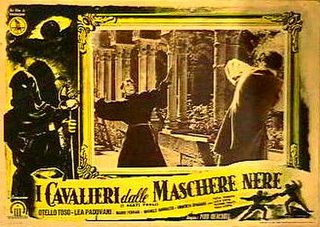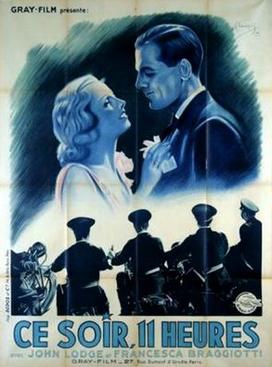
The Strega Prize is the most prestigious Italian literary award. It has been awarded annually since 1947 for the best work of prose fiction written in the Italian language by an author of any nationality and first published between 1 May of the previous year and 30 April.

Walter Annicchiarico, known as Walter Chiari, was an Italian stage and screen actor, mostly in comedy roles.

Massimo Serato, born Giuseppe Segato, was an Italian film actor with a career spanning over 40 years.

Massimo Girotti was an Italian film actor whose career spanned seven decades.

Paolo Stoppa was an Italian actor.
The Nastro d'Argento is a film award assigned each year, since 1946, by Sindacato Nazionale dei Giornalisti Cinematografici Italiani, the association of Italian film critics.

The Count of Saint Elmo is a 1950 historical adventure film directed by Guido Brignone and starring Massimo Serato, Anna Maria Ferrero and Tino Buazzelli. It was shot at the Farnesina Studios of Titanus in Rome. The film's sets were designed by the art director Ottavio Scotti.

Invisible Chains is a 1942 Italian drama film directed by Mario Mattoli and starring Alida Valli, Carlo Ninchi and Giuditta Rissone. It was shot at the Cinecittà Studios in Rome. The film's sets were designed by the art directors Ottavio Scotti and Mario Rappini.

Peppino, le modelle e chella là is a 1957 Italian comedy film directed by Mario Mattoli and starring Gino Bramieri.

Guido Celano was an Italian actor, voice actor and film director. He appeared in 120 films between 1931 and 1988. He also directed two spaghetti Westerns: Cold Killer and Gun Shy Piluk.

The Materassi Sisters is a 1944 Italian comedy film directed by Ferdinando Maria Poggioli and starring Emma Gramatica, Irma Gramatica and Olga Solbelli. The film is an adaptation of the 1934 novel of the same title by Aldo Palazzeschi. It was shot at the Cinecittà Studios in Rome.

Gladiators Seven is a 1964 Italian peplum film directed by Alberto De Martino and starring Tony Russel.
The Sin of Rogelia Sanchez is a 1940 Italian drama film directed by Carlo Borghesio and Roberto de Ribón and starring Germaine Montero, Juan de Landa and Rafael Rivelles.
The Carnival of Venice is a 1939 Italian comedy film directed by Giuseppe Adami and Giacomo Gentilomo and starring Cesco Baseggio, Toti Dal Monte and Junie Astor. It was made at the Cinecittà studios in Rome.

I cavalieri dalle maschere nere (I Beati Paoli) (also known as The Knights of the Black Masks and The Sect of the Hooded) is a 1948 Italian adventure film directed by Pino Mercanti and starring Otello Toso and Lea Padovani. It is loosely based on the novel I Beati Paoli written by Luigi Natoli.

Two on a Vacation is a 1940 Italian comedy film directed by Carlo Ludovico Bragaglia and starring Vittorio De Sica, María Denis, and Umberto Melnati. It was a remake of the 1932 German film Two in a Car. It was shot at the Cinecittà Studios in Rome.
The organization officially known as Volante Rossa "Martiri Partigiani", often mentioned simply as Volante Rossa, was a clandestine antifascist paramilitary organization active in and around Milan in the postwar to the Second World War, from 1945 to 1949. Led by "tenente Alvaro", nom-de-guerre of Giulio Paggio, it was made up of communist partisans and workers who aimed with their actions to build a continuity with the wartime action of the Italian Resistance.

Tonight at Eleven is a 1938 Italian "white-telephones" mystery film directed by Oreste Biancoli and starring John Lodge, Francesca Braggiotti and Ivana Claar.

Torrents of Spring is a 1942 Italian drama film directed by Nunzio Malasomma and starring Gino Cervi, Mariella Lotti and Vanna Vanni.

The Taming of the Shrew is a 1942 Italian comedy film directed by Ferdinando Maria Poggioli and starring Amedeo Nazzari, Lilia Silvi and Lauro Gazzolo. It is based on William Shakespeare's play The Taming of the Shrew, with the setting updated to modern-day Rome.















